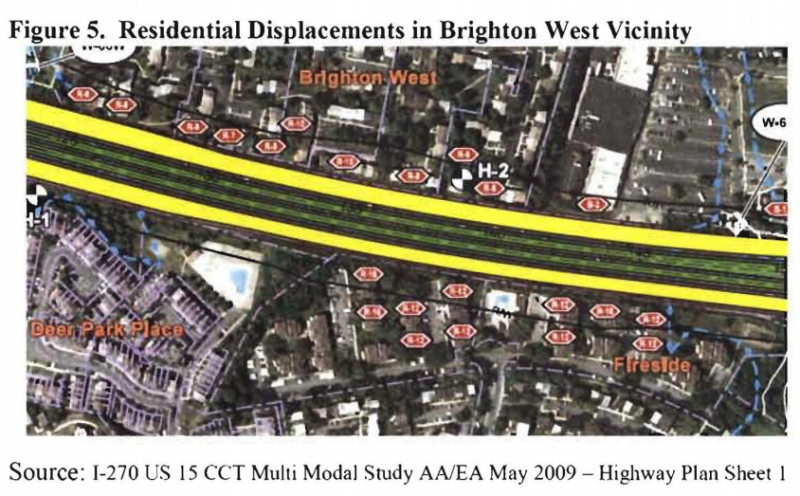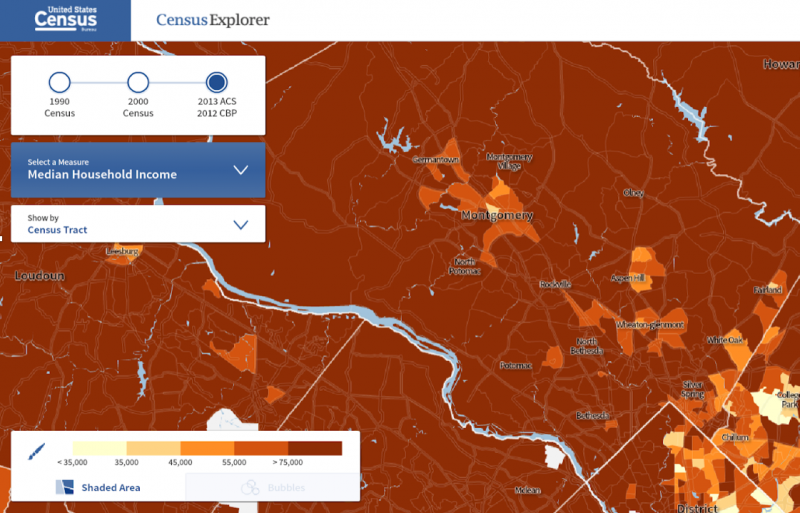Widening I-270 could demolish hundreds of homes and affordable homes

Brighton Village Apartments. Image created with Google Maps.
Last fall, Maryland Governor Larry Hogan announced an ambitious $9 billion dollar plan to add express toll lanes along I-270 and I-495 as well as the BW Parkway. The transportation merits of this project, the public/private construction, and bid process have been controversial, but a tremendous impact that has not received attention is the potential significant displacement of low-income residents along its path.
Similar to highway projects in the era of Robert Moses, this proposal would displace hundreds of low-income families and knock down affordable homes closest to the region’s job centers. At the same time, even those who don’t lose their house will lack access to the Express Toll Lanes (ETLs), as many of the interchanges in Montgomery County do not have right of way to build separate entrances to the ETL.
Studies show that homes will be destroyed
The 2009 Environmental Impact Study (which is missing from the Maryland Department of Transportation US15/I270 Multimodal Study website) is available through public meeting records such as the staff presentation for the Montgomery County Council. It says that hundreds of homes, mostly low-cost condos and apartments, are at risk, despite more recent comments by the Maryland Transportation Secretary saying that housing impacts would be minimal. If you look closely, this is simply not possible.
The 2009 study highlights impacts of the ETL from Frederick to I-370 on page 39-40 of the staff report. In this small section alone, the findings are dismal for low-income housing with anywhere from 251-365 homes displaced.
The study identifies several displacements in the Brighton Village Apartments. The Londonderry apartments also may have several units impacted, although these may be mitigated depending on availability of federal land on the NIST campus. In each of these cases, the expanded highway cuts into the existing properties, necessitating some level of demolition.
Given the large number of homes identified, the financial viability of these communities will likely become untenable. These are not state- or federally-subsidized homes, but rather are “market-affordable” homes, something that is increasingly rare in our region. Fewer units in these complexes contributing to maintenance and upkeep may prompt the remaining owners to sell their properties for redevelopment.
Given that there are no affordability protections on these properties, the resulting redevelopments would only have to follow the 15% workforce housing requirement instituted by the City of Gaithersburg. The result would be a loss of a large segment of housing that property records show are valued between $80k - $300k, depending on the size of the unit in a prime location near job centers.
Google map of Gaithersburg apartments along I-270 in satellite view. 
Image by Montgomery County.
The Montgomery County staff analysis notes that the safety requirements for ETLs require additional right-of-way that would produce significant business and residential displacements. While retaining walls and narrow shoulders may be used to reduce the impacts to 9-74 housing units, the impact cannot be truly known.
Despite proposing ETLs which generally require more room, the mitigation report in 2009 was much more optimistic than the 2002 report, which cited no fewer than 127 displacements. The 2009 report also notes safety issues with reducing shoulders and of course, traffic crashes may produce more congestion without adequate shoulders.
This situation could be widespread
In examining a map of census tracts for the larger region, this story continues not just for the areas studied in 2009 which primarily impacted City of Gaithersburg affordable housing, but for the broader current study area along I-270 and I-495.
An examination of median income around these highways shows concentrations of low-income housing along the edge of the highway, especially in Montgomery County. Those with the least ability to fight a highway expansion would be impacted the most.
Image by US Census Explorer.
Interestingly, even those who might benefit the most from the ETL proposal in Frederick County have expressed concerns that the funding for I-270 will defer work on more urgent local congestion relief on US-15, which is not included in the recent widening proposals.
Furthermore, the 2009 study examined the corridor from Frederick to I-370 only, but found Level of Service barely improved under all scenarios, primarily continuing to function at Level of Service D or F even after the improvements during peak rush hour times.
The resulting loss of affordable housing units would push these families to relocate much further away, increasing the very traffic that the widening seeks to avoid and likely furthering the region’s east/west income divide. These low-income families would have higher transportation expenses potentially pushing them into further poverty.
The original 2009 study included transit alternatives such as the Corridor Cities Transitway (CCT), but Maryland has deferred further investments and as of right now, it won’t be constructed.
In short, the addition of ETLs would do little for congestion, provide minimal improved travel times from the densest housing areas in Montgomery County (since access points would be primarily far north), and displace large segments of affordable and low-income housing along its route.
Innovative approaches like the recently-announced spot improvements along I-270 and concentrated ETL efforts to relieve traffic from choke points such as the merging traffic around the American Legion bridge may eventually prove worthwhile. (These projects actually improve level of service to grade B or C through 2040 and beyond.)
However, the I-270/I-495 ETL project needs to answer these displacement concerns, which might be the most costly of all. The public will get another opportunity to comment this summer on this project according to the timeline.
GGWash sometimes organizes around issues affecting our region. Should we consider advocacy around this topic? Let us know!

